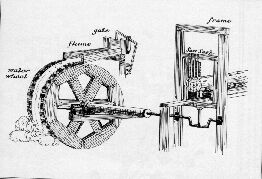The mill dam is about 70 feet long and is quite impressive, with tall, built-up stone
walls on both sides. Additional stonework was added for fill and mass along the entire length.
The dam is typically about 15 feet wide, although it is stepped in plan and narrower by
about 6 feet at its north end.
The basin which lies left (and west) of the mill dam was clearly a mill pond. A stream
still flows across the old pond bed, towards and under the dam. Sawmill Stream traverses
the mill dam, by way of an underground, stone-lined tunnel which penetrates the mill dam.
This partially silted-in, main power sluice directs the stream to the mill waterwheel pit,
which lies adjacent to the downstream side of the dam and a level terrace-the latter
survives at the machinery floor level of the old mill. On the machinery floor level
there are several stone slabs which have projecting iron bolts and hollowed out areas.
These were designed to accommodate cylindrical shafts-possibly a waterwheel axle.

From Mills on the
Tsatsawassa. Philip L. Lord, Jr. Martha A. Costello, Illustrator (Albany, NY: State
Education Dept., 1983)
Other impressive features in the mill dam area include a pair of spillway
sluices which penetrate and cross the mill dam near its north end. This elaborate
construction runs about 100 feet downstream, easterly and perpendicular to the mill dam.
The spillway stone wall is aligned with the spillway sluices, which was evidently
designed to keep the excess spillway water away from the main stream bed and mill
location in times of freshets or intentional pond drainage. The spillway ramp joins
the main stream course below and east of the mill site (2).

Detailed view of system show on main page. From Oliver Evans' 1807 The Young Millwright.
Table of Contents